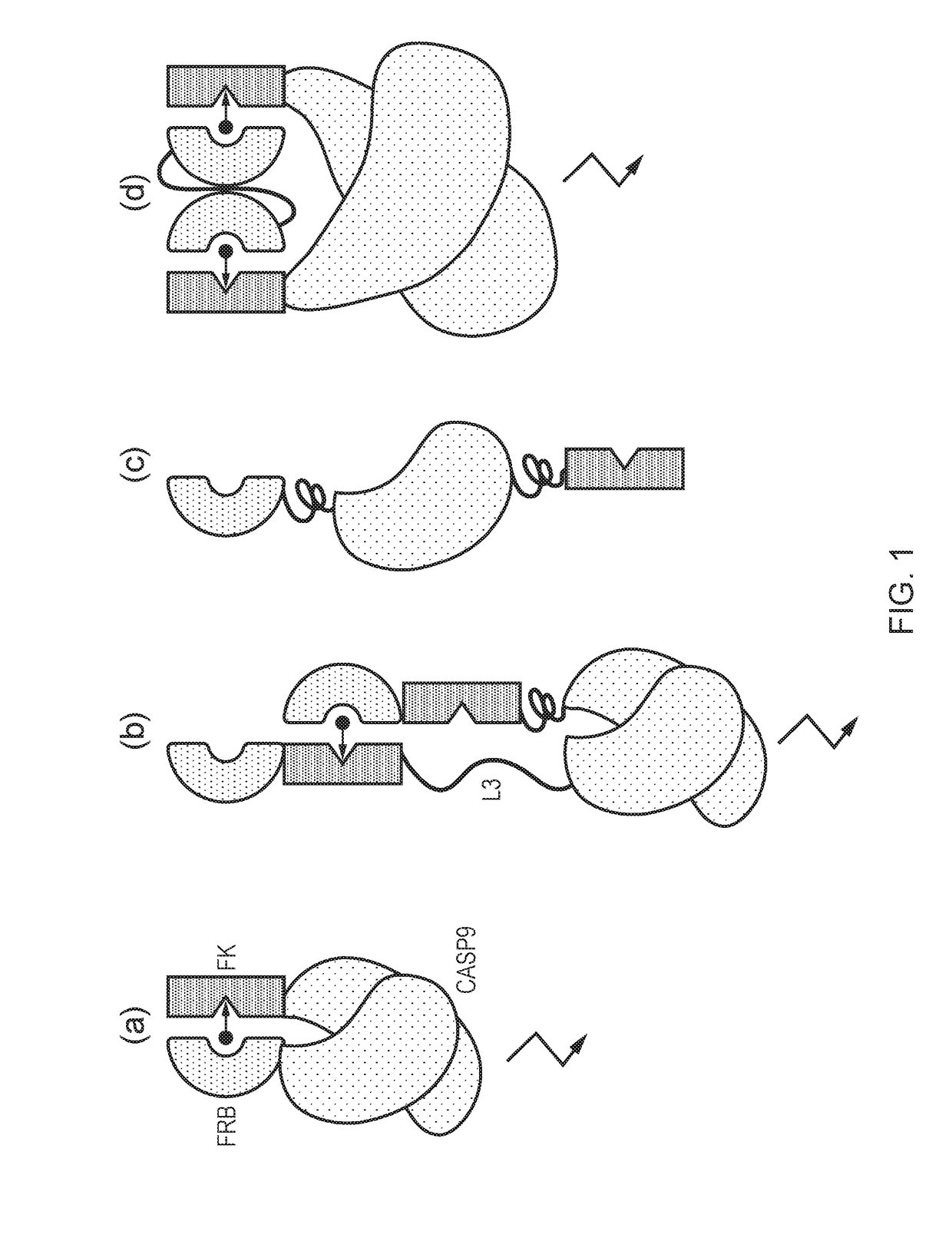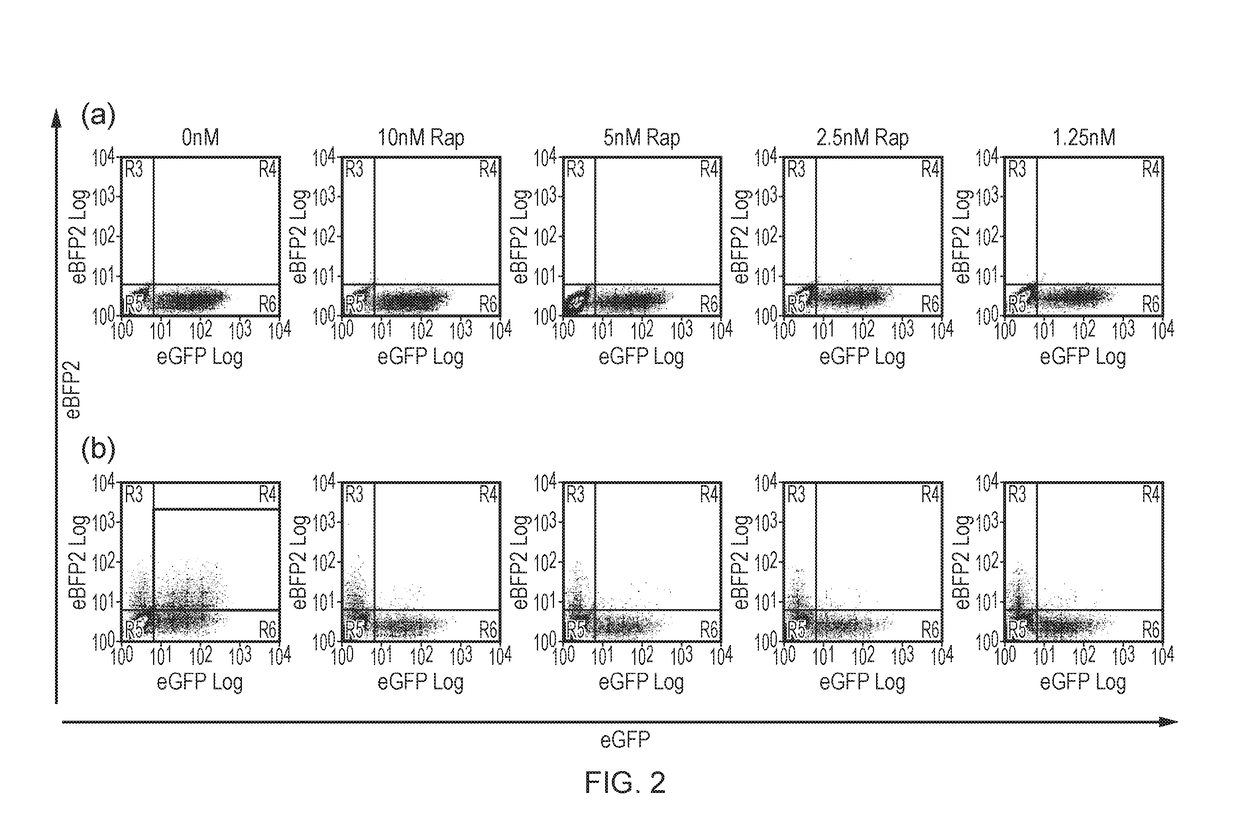Chimeric Protein
- Summary
- Abstract
- Description
- Claims
- Application Information
AI Technical Summary
Benefits of technology
Problems solved by technology
Method used
Image
Examples
example 1
Production of T-Cells Expressing Chimeric Proteins
[0297]T-cells were transduced with the different constructs. For the two-molecule rapCasp9 (FIG. 1a), T-cells were transduced with two vectors: one coding for FKBP12-Casp9 co-expressed with the green fluorescent protein eGFP by means of an internal ribosome entry sequence, and the other coding for FRB-Casp9 co-expressed with the blue fluorescent protein eBFP2. For the one molecule rapCasp9 (FIG. 1b), T-cells were transduced with just one vector coding for the respective rapCasp9 which are co-expressed eGFP. A construct which provided FKB12-Casp9 and FRB-FRBw was encoded in a tri-cistronic cassette whereby the FKBP12-Casp9 and FRB-FRBw were co-expressed using a FMD-2A like peptide and eGFP was co-expressed with an IRES. The T-cells were intentionally only partially transduced so within the cell culture a proportion of cells remained non-transduced to act as an internal negative control. As a further control, T-cells were transduced wi...
example 2
Testing Deletion of Chimeric Protein-Expressing Cells with Rapamycin
[0298]T-cells were exposed to different concentrations of Rapamycin and incubated for 48 hours. Following this, T-cells were stained with Annexin-V and 7AAD and analysed by flow-cytometry. By gating on the live cells, and interrogating the population of cells expressing fluorescent proteins, survival of the transduced and non-transduced populations could be clearly measured. The dual FRB-Casp9 and FKBP12-Casp9 approach resulted in effective deletion of only double positive cells as expected. The FKBP12-FRB-Casp9 construct resulted in effective deletion of single positive cells. The FKBP12-Casp9-FRB construct resulted in minimal deletion. The FKBP12-Casp9 / FRB-FRBw resulted in effective deletion of single positive cells. The control resulted in no specific deletion (FIGS. 2 and 3).
example 3
Testing an Expanded Set of Constructs
[0299]The constructs shown in FIG. 5 we generated and transduced into Jurkat cells. Transduced cells were mixed with non-transduced (NT) cells to have both construct positive and negative cells within the population. Rapamycin was added at a concentration of 0, 1, 10, 100 and 1000 nM and the cells were incubated for 24 h.
[0300]Following harvesting, the cells were stained with PI and annexin V and analysed by FACS. The results are shown in FIGS. 6 to 9 and summarised in FIG. 10.
[0301]The construct which has a configuration as defined according to the first embodiment of the first aspect of the invention, namely MP20244, performed very well in this assay, giving very efficient killing of transfected cells at all concentrations of rapamycin above and including 1 nM.
[0302]The pair of constructs having a configuration as defined according to the second embodiment of the first aspect of the invention, namely MP20206 and MP20207 also performed very well...
PUM
 Login to View More
Login to View More Abstract
Description
Claims
Application Information
 Login to View More
Login to View More - R&D
- Intellectual Property
- Life Sciences
- Materials
- Tech Scout
- Unparalleled Data Quality
- Higher Quality Content
- 60% Fewer Hallucinations
Browse by: Latest US Patents, China's latest patents, Technical Efficacy Thesaurus, Application Domain, Technology Topic, Popular Technical Reports.
© 2025 PatSnap. All rights reserved.Legal|Privacy policy|Modern Slavery Act Transparency Statement|Sitemap|About US| Contact US: help@patsnap.com



